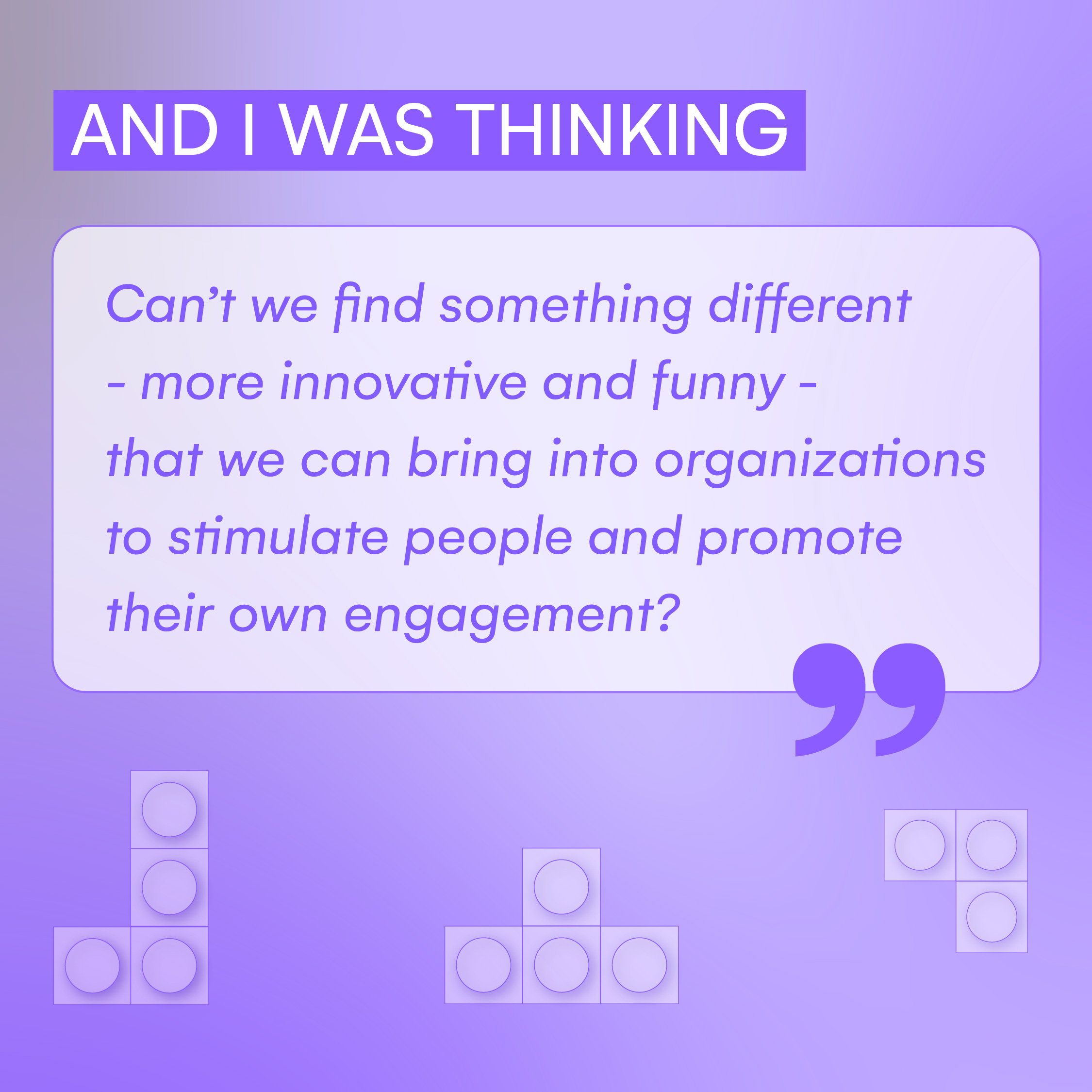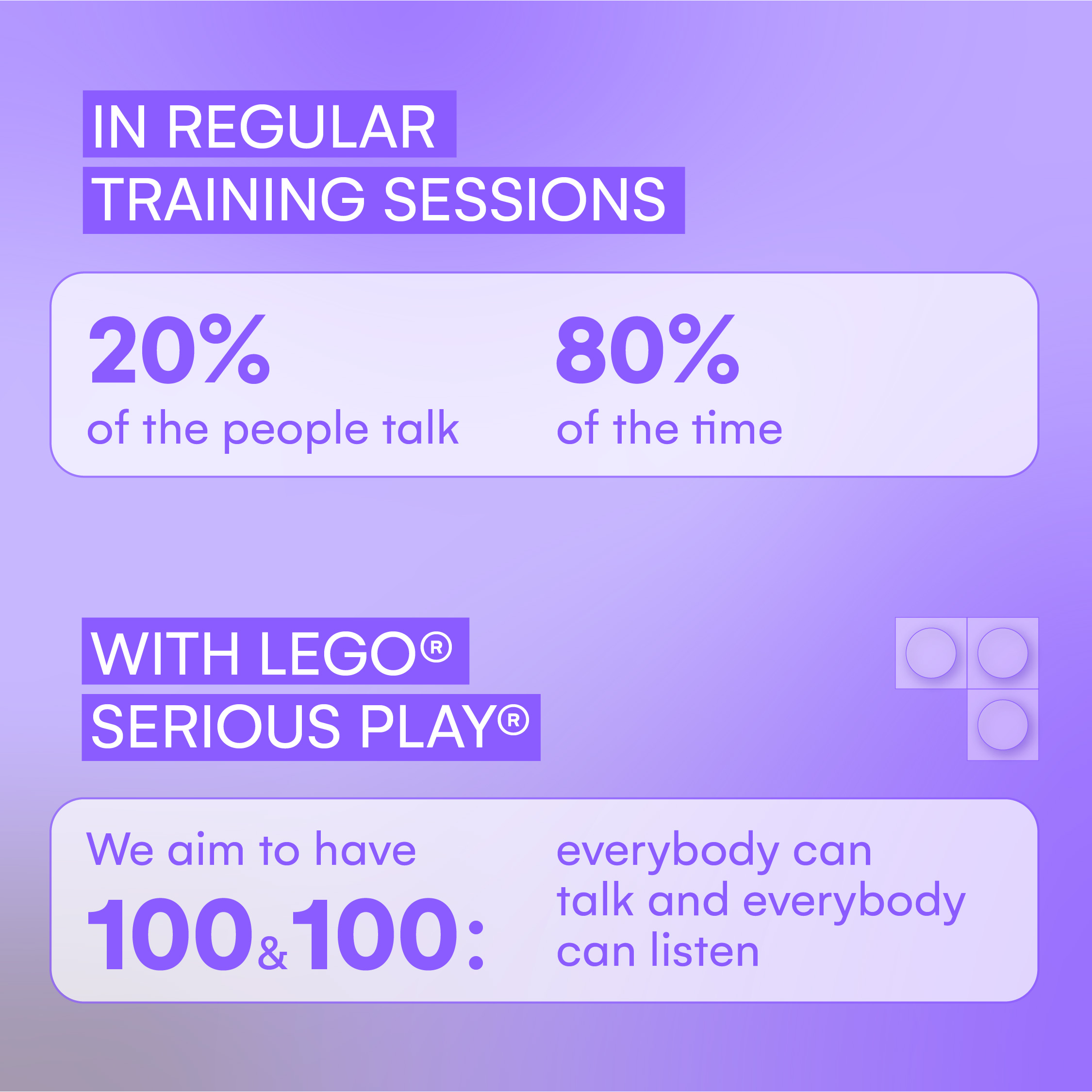Can adults (still) learn through play? Can corporate training be made more engaging and fun? Yes! And there’s even a learning methodology that for these purposes uses something everyone will remember from their childhood: LEGOs!
It’s called LEGO® SERIOUS PLAY®.
In this interview, Rita Oliveira Pelica, Certified LEGO® SERIOUS PLAY® facilitator and founder of ONYOU, takes us on a journey to explore the power of using LEGO bricks as a tool for experiential learning in corporate training.
Discover how LEGO® SERIOUS PLAY® hands-on engagement taps into the power of imagination, storytelling and creativity, creating a safe space for collective learning experiences.
I would say that maybe I was one of those people at the beginning. I know that at first, it might feel strange but, when you experience it, you can really understand why this combination of elements works. And sometimes, when I start my training and I see that look on someone’s face that says: “Really? Are we going to use the LEGOs in this entrepreneurship class?”, I tell them two things:
1. It’s not just playing for playing’s sake, we are playing with an intention. For example, we are prototyping our products, improving our services, or reflecting on the things we enjoy the most in our jobs. It’s this idea of being playful with a purpose.
2. I want you to be present. LEGO® SERIOUS PLAY® ‘s sessions are very analog and this helps participants to enter a kind of “flow mode”, where they are focused on what they are doing, more connected, and committed to the situation.
And, most of the time, at the end of the session those who in the beginning were more suspicious … are the most enthusiastic ones!
For almost 20 years I worked in management and in the human resources area: leading teams and delivering training. When I entered my 40s, I was having my “midlife crisis”: I was getting bored of my job. I was feeling that everybody in the Learning & Development area was doing things in the exact same way. What’s worse, I was feeling that the trainees that I was assisting were getting bored. They were not involved in their own training and their own education.
Well, the answer is yes! In 2016, while doing some other training, someone told me about LEGO® SERIOUS PLAY® and it immediately resonated with me. It got me so curious that I had to Google it, to study and go play with the LEGOs – because I hadn’t played with them in the last 30 or something years. And when I experienced the methodology with a facilitator, I discovered the power of using our own hands and of building our own stories. It was so exciting and engaging, that I immediately said “this is what I wanted to do”.
So I decided to quit my job, in the company where I had been for 9 years, to bring this idea of experiential learning with hands-on activities, to create some kind of revolution in the training area.
I founded ONYOU and, for the last six years, I’ve been happy. I can say that I’ve been really blessed by doing the things that I love.
The idea behind this methodology is different. Here’s the kicker: when adults are playing, magic happens. We use LEGOs to deliver training, to go into companies, and make people understand that they can be innovative and learn in a more joyful way. It’s all about playfulness – playing with an intention.
It’s a facilitated method, meaning that there’s a facilitator who poses the questions and participants who “build” the answers. In fact, one of the major things of LEGO® SERIOUS PLAY® is asking the right questions. By posing the right questions, participants will create their own answers. This is something very different from the “traditional” method, where you can find a trainer talking, and talking, and talking. Here the participants are part of the process: we use the bricks as a means to build our knowledge, to tell our stories – and then to listen, to learn from others.
Finally, it’s about thinking by design, not by default. Letting people use their own imagination, creativity, communication, critical thinking, and collaboration skills. And feeling secure while doing that, by creating a safe space for people to experiment and share.
For us adults it’s this little thing called imagination. We grow up and it seems that we forget to use it because we have to be so serious. Or even, sometimes we are so afraid to even try because … what if we fail? But, when we use the bricks with our own hands, we can finally tap again into our imagination. And there’s two reasons why.
Firstly, we know that the hands by far of all senses have the most connections to the brain – probably up to 70 or 80%. So when we build with the LEGOs we are really producing information: going back to our memories, feeling connected to the concreteness of the present moment. In fact we could also define the LEGO® SERIOUS PLAY® approach as “handstorming”, or “hands knowledge”.
Secondly, there’s the power of the metaphor. The LEGOs become vehicles of concepts, symbols, memories – and participants use them in order to build, unbuild and rebuild again, creating their own stories. And sometimes it’s unconscious. For instance, let’s say that to represent empathy you create a yellow giraffe … and then you discover that yellow really is the color of empathy! Because, in line with Piaget’s constructivism, when we are building things we are really producing our own knowledge. And this also helps to create that safe space of sharing, because we are not “pointing fingers”: we are just talking about the bricks.
One of the sweetest memories that I have is from a group in Sudan, of around 50 people. And I will never forget the smile on their faces as they were building together, collaborating and co-creating stories. They looked like happy children! In fact, as they told me at the end of the session, they had never played with the LEGOs before, even when they were younger.
But, you know, every session is remarkable in its own way. Even though we might be working on the same topic, each session is a different session and a special one. I know how the session starts, but I never know how it will end. Because people are different: we have different communications styles, and hence different building styles. It’s lovely to deal with this unknown and unlock the creative power inside of everyone.
Because when you are motivated, you are going to involve people and they will be committed - and that’s how they will be best served.
We need to understand why we are doing the things that we are doing, why we should care about them, making our intention and impact very clear.
Be accountable for your learning choices and decide what’s important to you, why you choose course 1 and not course 2: it’s on you!





